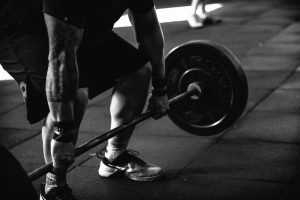 The first things we focus on at Iron Fit in San Antonio, Texas, are lifting techniques, proper weight placement and posture. Those factors are important whether you’re lifting a box, a child, barbells or kettlebells. In other words, they’re always important. You’ll help prevent injuries when you use proper form. Proper form allows you to work on those muscle groups you intended, workout longer, prevent muscle imbalance and injuries. It helps you stay safe so you can workout longer and progressively get stronger.
The first things we focus on at Iron Fit in San Antonio, Texas, are lifting techniques, proper weight placement and posture. Those factors are important whether you’re lifting a box, a child, barbells or kettlebells. In other words, they’re always important. You’ll help prevent injuries when you use proper form. Proper form allows you to work on those muscle groups you intended, workout longer, prevent muscle imbalance and injuries. It helps you stay safe so you can workout longer and progressively get stronger.
Warm up first before you start.
Start by making sure your muscles are ready for the workout. The warmup can get your cardiovascular system going and increase the flow of blood to your muscles. It helps loosen tendons, ligaments and joints. Warming up can be as simple as jogging lightly or any other aerobic exercise. Don’t try to lift too much too soon and focus more on quality, rather than weight and quantity. You should start with a weight you can lift approximately 12 to 15 times comfortably. It’s better to go too light when you’re learning proper technique, than to make the mistake of going too heavy.
Proper form is top priority.
When you’re lifting weights, you need to ensure you’re moving through your full range of motion for your joints. Rather than pushing through lifting heavier weights, with a potential for injury. You need to focus on form when you’re just beginning. Good form doesn’t guarantee you’ll never have an injury, but it reduces the chances significantly. Don’t forget, proper form is important outside of the gym, too. It’s also important when you’re taking or replacing weights from the rack.
Good posture is important both in and outside the gym.
When you focus on good posture, you’ll prevent abnormal wearing of joints, ensure your joints and bones are correctly aligned so muscles are properly used and relieve stress to the ligaments in the back that maintain the joints in the spinal column. Good posture also helps prevent early fatigue due to more efficient use of the muscles, which means less energy is used. Not only does proper posture help prevent the spine moving to abnormal positions, it helps reduce the potential for backache.
- How you breathe while lifting makes a difference. Don’t hold your breath. As you lift, breathe out and as you lower the weight, breathe in.
- Workout slower, especially at first. An unhurried, controlled way and taking it slowly helps you isolate the muscle groups you want to work, rather than depending on momentum.
- Make sure you work all groups of muscles in your program. If you’re working with a personal trainer, the trainer does that for you. If you’re working out on your own, balance your workout for opposing muscles and include muscles in the hips, legs, chest, back, abdomen, shoulders and arms.
- Make sure you take at least a day break after strength training to ensure your muscles have time to repair and recover. Never work the same muscle groups two days in a row.
For more information, contact us today at Iron Fit
